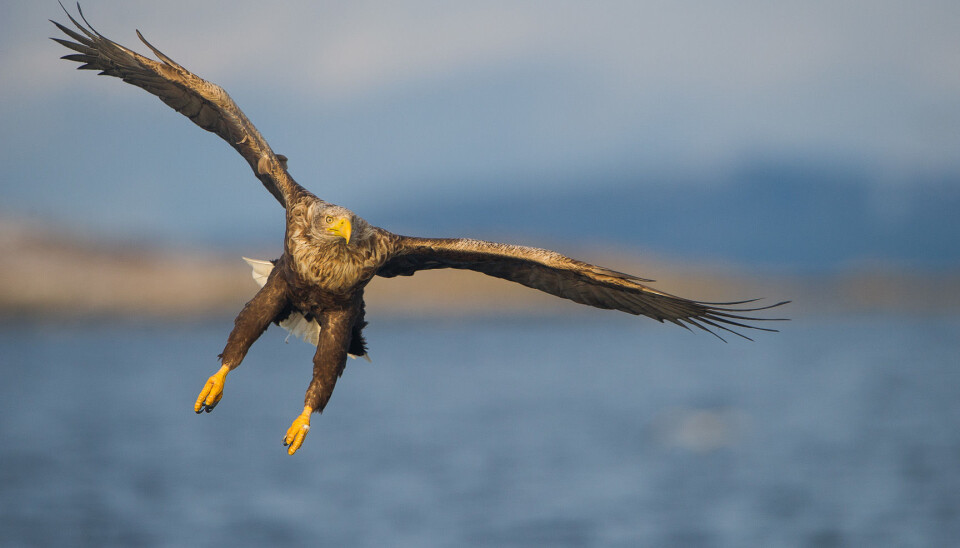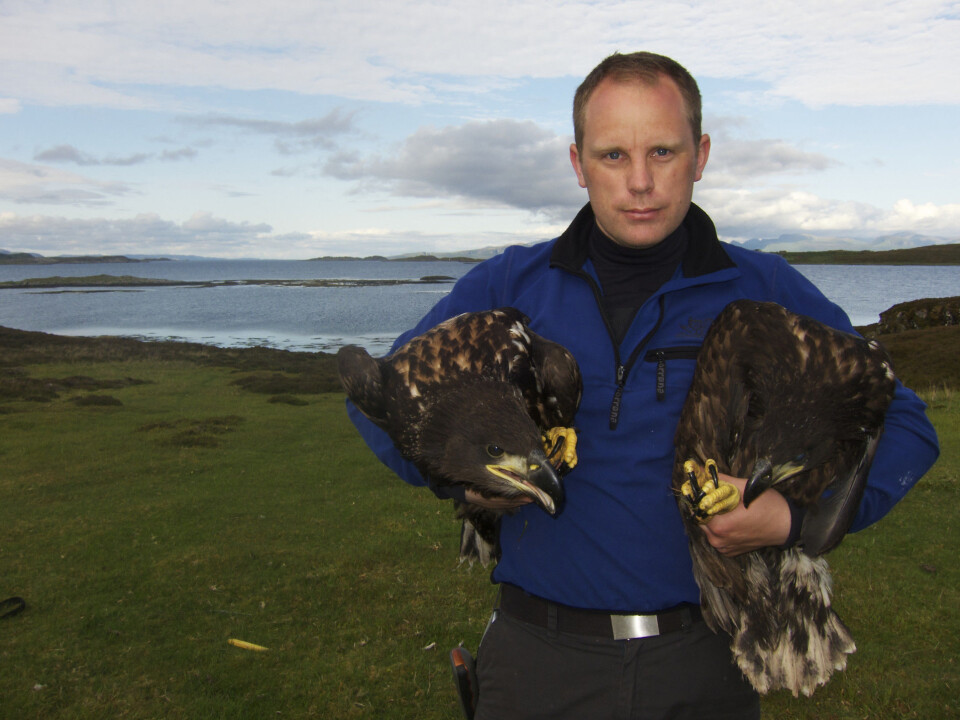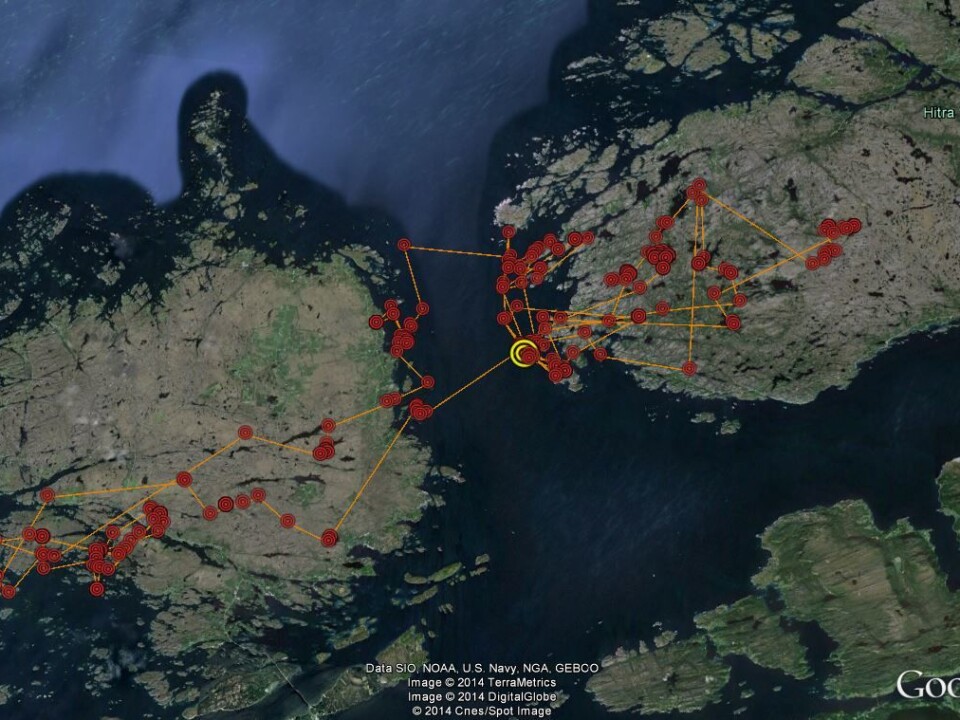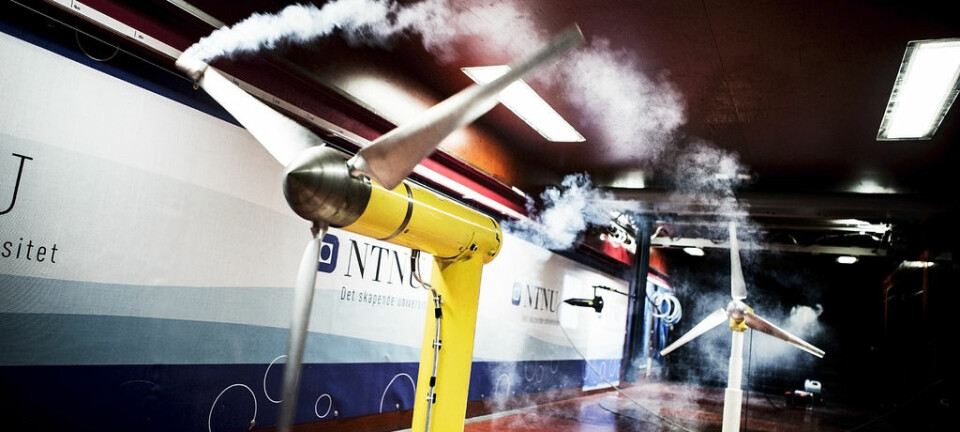An article from Norwegian SciTech News at NTNU

Five kilometres between life and death for the sea eagle
DNA profiles of the sea eagle population from a large island in mid-Norway are providing new and useful information as to how the birds avoid being killed by wind turbines.
Denne artikkelen er over ti år gammel og kan inneholde utdatert informasjon.
Sea eagles and wind turbines have a difficult relationship, as experience has shown time and again. The construction of a wind farm can cause birds to leave their territory, and the ones that stay often die a sudden, brutal death. Is it possible for us to help prevent this fundamental conflict and reduce fatalities? New research says yes.
Smøla, a large island in Møre og Romsdal, has Norway’s densest population of sea eagles. It also is home to the largest wind farm in the country. This makes it the ideal place to research the difficult relationship between birds and wind turbines.
Espen Lie Dahl has been studying the effect of the development of Smøla’s wind farm on the nesting sea eagle population in the area, and the ensuing mortality rates. He recently defended his PhD thesis “Population dynamics in white-tailed eagles at an on-shore wind farm area in coastal Norway” at NTNU.
“The wind farm affects sea eagles, that’s for sure. But it all has to do with distance from the turbines. If you live far enough away, you’ll probably be fine,” he says.
Lack of concrete information

Espen Lie Dahl has grown up on Smøla, and has always had an interest in birds, especially sea eagles. He knew about almost all of the nests on the island even before he started studying the population scientifically— first with master’s degree at NTNU, then with his doctoral research.
“When they started constructing the wind farm on the island, we quickly understood that sea eagles would be an important issue, but we lacked sufficient information about the species,” Dahl explains.
DNA profiles are the key
The key to understanding the birds’ lifestyle has been their DNA.
“DNA profiles have been essential. We began collecting DNA in 2006, and quickly understood that there was a lot that we didn’t know. The biology and habitats of the species were a lot more complex than we expected. We’ve gained a lot of new and precise information from DNA profiles,” Dahl says.

Every year, he visits all of the nests on Smøla, taking blood samples from the young birds and collecting feathers from the adults. Over time, they have built a DNA index of the population.
“This means, among other things, that when an eagle collides with a turbine, we can check its DNA in the index to see where it lived,” Dahl explains.
And knowing where deceased bird lived is essential.
The border between life and death
Since the wind farm was established twelve years ago, research has shown that one-third of deceased adult sea eagles died in a collision with the rotor blades of a wind turbine. That’s 57 individuals, all told.

Many of the birds that have died by flying into the wind turbines had their nesting territory within a five kilometre radius of the wind farm, meaning that the population in this area has dropped since the wind farm was built. The survival chances of a bird within this radius has gone from 96 to 94 per cent.
But the Smøla population as a whole has remained stable at 50 breeding pairs of eagles.
“This means that the birds living outside of the five kilometre limit are living well enough to make up for the population decrease within the wind park area,” Dahl says.
Slow reproduction
Sea eagles live for a long time, up to 30 years, and it takes five years for an eagle to reach sexual maturity. When it does, it finds a partner that it stays with its whole life, assuming that the partner doesn’t die prematurely. Eagles hatch on average 0.6 young every year, meaning that they will have one to two babies every other year.

When it comes to reproduction, only the couples with nests inside a radius of about one kilometre from the turbines seem to have their ordinary mating habits disturbed. But the fact that sea eagles live for so long and have so few offspring means that the mortality within the five kilometre radius effects the population a lot more than reduced reproduction does.
For another species that does not live as long and reproduces more quickly, mortality among adult individuals would have a much less dramatic effect.
“Most previous studies have only measured the effect on the birds’ reproduction, which is easier to study than mortality. But mortality is more important, and affects birds that live farther away from the turbines. But now we’ve learned how important the five kilometre limit is for survival, and we have gained a lot of knowledge about the importance of the survival of adult birds,” Dahl says.
A trip to Northern Norway
Dahl also wants to know where sea eagles go throughout their adolescent and adult lives. So he has attached satellite senders to a number of young birds. As of today, 15 of these birds are alive, and researchers can follow their wanderings from their computer screens.
He has observed that the young eagles begin to explore the area around where they live during their first autumn, and fly back home to Smøla for the winter. Come spring, the desire to explore awakens, and they fly up north. According to the data the team has collected, the female birds fly farthest north.
But every winter, they come back home to Smøla. This continues for five years, until it’s time to get married. When they find a partner, they settle down in one of the areas around their place of birth, and stay there for the rest of their lives.
Sea eagles thrive on Smøla, because there’s plenty of shallow water around the island where it is easy to catch fish, either by hunting themselves, or by stealing from seagulls who have had better luck.
“Eagles are both smart and lazy, and they will happily steal from others. They’re quite similar to vultures in that sense,” Dahl says.
Why do they collide?
Sea eagles have good eyesight, and they fly well. So why aren’t they able to see the enormous wind turbines?
There are a few theories to explain the problem. Most accidents happen during the spring, which makes sense, seeing as this is when there is most activity in the air. But it may also be because the eagles become distracted, trying to chase away intruders that get too close to their territory.
Another theory is that when birds get too close to quickly spinning rotor blades, the blades blur and become difficult to see. Researchers have thus initiated a new project to find a way to make the rotor blades more visible to birds. They started by painting single rotor blades black, and are also working on testing the effect of attaching UV or laser lights to the turbines.
This research is part of project INTACT, which has been organised by Cedren (Centre for Environmental Design of Renewable Energy) and NINA, the Norwegian Institute for Nature Research, where Espen Lie Dahl is now continuing his work with sea eagles.
Measures to reduce mortality
The research has shown that it is possible to reduce mortality rates by taking certain measures:
- Building wind turbines at least five kilometres from all nesting areas.
- Shutting down the turbines during the spring when activity in the air peaks.
- Making the rotor blades as visible as possible using colours and lights (the effect of this is currently being tested).

































